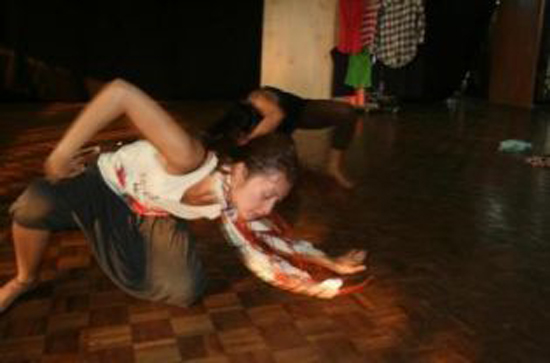
True to form, it is three nights out from opening night and props are still being hammered together. Dancers waltz in late - after a last minute dash to find a costume.
But despite what many outsiders to the dance world may see as a lack of organisation, things are on schedule for i-Move, a collection of contemporary works by up-and-coming Indonesian choreographers.
And despite a few admissions of opening-night jitters, 27-year-old choreographer Ajeng Soelaeman, one of the masterminds behind the show, is still excited.
“It is the first time we have come together as a group,” she said. “But we hope that this show won’t be our last, we want to make it an annual event.”
Ajeng has joined forces with five other young choreographers, aged 24 to 27, to bring a unique fusion of contemporary choreography to Jakarta this weekend.
Each night three choreographic works will be performed in hour-long programmes at the Teater Kecil, Taman Ismail Marzuki’s stage in Cikini Raya, Central Jakarta.
Ajeng said the show, which will involve around 20 dancers, was the beginning of “Indonesia’s dance movement platform for the youth".
“We want to show the older generation that we as youth have something to share.”
Making their mark
Choreographer Andara Moeis, the other mastermind behind i-Move, said as young choreographers they wanted to make their mark on Indonesia’s dance floor.
After all, five of the show’s six choreographers were trained at Indonesia’s own Jakarta Institute of the Arts, and in the years since graduating they have all been contributing to the dance scene as teachers, dancers and now as choreographers.
I-Move’s opening night will draw the curtains on Ajeng’s own self-choreographed solo variation, the beginning of her 20-minute choreography called Baju Kini.
Dressed in yellow and orange, Ajeng will flit around with her own dance troupe, incorporating her second passion in life - clothes.
With clothes hanging off a line, being used to frame the background, and the movement of the dancers winding in and out, there’s a lot for the eye to follow.
Even within the rustic setting of one of JIA’s rehearsal spaces, Ajeng and her group provided an entertaining sneak preview of i-Move, with its share of humor, allusions of flirty romance and dynamic, playful movements.
There weren’t many straight body-lines to be seen in Ajeng’s choreography, despite her background as a classically trained soloist with the Namarina Ballet Company.
Modern counterpart
There were brief glimpses of her former dance career, but quickly it glided through, rebounding into its more modern counterpart.
Gone was the flowing lyricism and in its place were urgent, flickering movements, twists and swift directional changes that kept the head turning from one side of the makeshift stage to another.
Ajeng had been with the Namarina Ballet for many years, first as a young child in its dance school and then in its company until she was 20.
Over the years she said the perfection of ballet became too much to handle.
“I was sick of being a diva,” she laughed.
Instead, through the Bachelor of Dance program at JIA, “I found my world” in contemporary dance, she said.
On graduating she became a part of internationally acclaimed choreographer Jecko Siempo’s dance group, an experience Ajeng considers a highlight of her career and the stepping stone for her success.
Leap to fame
But this weekend Ajeng is making her own leap to fame, from dancer to choreographer.
“It’s hard,” she admitted “But it is good to be able to express myself.”
On the other side of the stage, fellow choreographer Andara’s story could not have been more different. “Modern dance” was something she had practiced her whole life.
“In kindergarten I did traditional dancing,” she said. “Hip-hop and R’n’B at high-school.”
But since her days at the JIA, Andara said her dance had been shaped more by contemporary styles of movement.
“It has become the basis of my work,” she said.
The inspiration for her latest work, i-Body, to be performed on Saturday, is the human body. Five dancers will perform Andara’s vision to “separate the two parts of the body, from hip to toe and hip to head,” she said.
“In this piece I don’t [have a narrative] from A to Z, but I have an image of the dance as the memory of the body and how it adapts.”
Truest form
Andara said with her work she wanted to invite young people to appreciate contemporary dance in its truest form. She said it was important to fight the preconceived notion that as young dancers it was all about being famous and being on TV.
There is a distinct difference, she said. “Contemporary dance is not the same as entertainment — it is art.”
As dancers, Ajeng said their focus is not the money — it’s about expression.
“People think all we care about is the money, but we are art students. We want them to know we are serious about our art.”
However she is also the first to admit that the biggest challenge for their show was the financial side. With no sponsorship, no funding and no production team, creating an hour-long show was an ambitious goal — at an estimated cost of between Rp 60 million to Rp 80 million (US$7000 to $9000).
Yet Ajeng said they have managed to do it all on their own, using their own money, in just three months. A huge feat considering that to make a living they all juggled day jobs, as teachers, dancers and choreographers for other companies.
“Dance doesn’t make enough for a living, that’s why I teach at the JIA,” Ajeng said with a laugh. “But I love to teach.”
And despite the challenges, Ajeng did not appear to be the type to give up dancing. It was not an option, really, with such an artistic family, she said.
With her sister a dancer, her mother a gymnast and her father a painter, being an artist seems to be in her genes.
This article is republished from the Jakarta Globe.



